| Pages:
1
..
4
5
6 |
elementcollector1
International Hazard
    
Posts: 2684
Registered: 28-12-2011
Location: The Known Universe
Member Is Offline
Mood: Molten
|
|
I now have fairly conclusive evidence that copper is the noted impurity.
For starters, the green solution from earlier was filtered and mixed with very concentrated NaOH solution. This produced a yellow precipitate at
first, but upon addition of more NaOH this darkened to a green and then brown precipitant, finally settling at dark brown. (Likely CuO.)
Then, upon filtering the solution, it was first yellow, then brown (these are likely colloidal colors), then green (same olive green as starting), and
now it's dark blue, leading me to suspect sodium cuprate. Another possibility is chromium, yet although being more common in minerals like
skutterudite it doesn't explain the brown colors.
I suppose I'll have to reacidify this with HCl until the mess of arsenic oxide and copper hydroxide precipitates, then... do something to separate
those two?
Elements Collected:52/87
Latest Acquired: Cl
Next in Line: Nd
|
|
|
blogfast25
International Hazard
    
Posts: 10562
Registered: 3-2-2008
Location: Neverland
Member Is Offline
Mood: No Mood
|
|
If there really is copper present, take a small amount of the original solution and add an excess of strong ammonia to it. The deep blue of copper
(II) ammine complex is hard to mistake.
Copper would initially precipitate with NaOH to blue Cu(OH)2, which in very strong NaOH will dissolve to deep blue cuprate. CuO would only form on
heating of the Cu(OH)2. The green could be explained by tetrachlorocuprate (but only if there's a lot of chloride in the solution).
You should also test for iron with K (or NH4) thiocyanate.
|
|
|
elementcollector1
International Hazard
    
Posts: 2684
Registered: 28-12-2011
Location: The Known Universe
Member Is Offline
Mood: Molten
|
|
The solution was extremely hot when precipitation was happening, likely due to NaOH neutralizing tons of excess HCl (of which there was assuredly
plenty).
Don't have any thiocyanate, so that's a no-go.
Elements Collected:52/87
Latest Acquired: Cl
Next in Line: Nd
|
|
|
elementcollector1
International Hazard
    
Posts: 2684
Registered: 28-12-2011
Location: The Known Universe
Member Is Offline
Mood: Molten
|
|
Results are in - this is not copper. Ammonia had no effect on the brown precipitate (which, if CuO, should have reacted
immediately). The only other candidate I can think of is chromium, but given the prevalence of blue and violet colors at high pH, this seems so
unlikely. In addition, to my eye, the green solution and the ammonia made a yellow solution, possibly indicative of chromate. Uugh, it only gets
worse!
Testing on whether the pH~7, yellow liquid resulting from the green solution and sodium hydroxide - HCl combinations is pending. In the meantime, I
thought some of the insoluble residue from the initial nitric acid dissolution that was mixed in with the white arsenic oxide might be elemental
arsenic, so I plan to attempt to sublime some of this powder.
I think I might have to restart this with a new sample of skutterudite - I have so many solutions resulting from the initial dissolution that I
frankly don't even know what happened to the arsenic anymore!
EDIT: The insoluble residue tests positive for arsenic and has a density of ~5g/mL, within acceptable bounds for As's 5.727 g/mL given my sloppy
techniques. The only thing left to do for this is test whether the initial ore has the same density (which it well might!) According to MinDat,
skutterudite has a measured density of ~6.5g/mL, so I might have to use some more refined techniques... Given that I only have 0.5g of the unknown
substance, and significantly more of the initial ore (a few g remaining), I'd like to know if there are any more accurate volume measurements than
water displacement.
[Edited on 5-18-2014 by elementcollector1]
Elements Collected:52/87
Latest Acquired: Cl
Next in Line: Nd
|
|
|
blogfast25
International Hazard
    
Posts: 10562
Registered: 3-2-2008
Location: Neverland
Member Is Offline
Mood: No Mood
|
|
I'm not so sure about that: freshly precipitated CuO will be more sluggish towards NH3 than freshly prepared Cu(OH)2. Could cause a false negative. It
would be better to test straight on the solution (neutralising the HCl with NH3 and then add excess).
Chromium: alkalise and add peroxide. A yellow/orange colour that causes precipitation with Pb(NO3)2/Pb(OAc)2 would mean Cr(III) (to Cr(VI)).
|
|
|
elementcollector1
International Hazard
    
Posts: 2684
Registered: 28-12-2011
Location: The Known Universe
Member Is Offline
Mood: Molten
|
|
Per the test for copper: I did that too. Solution turned clear, then yellow, no precipitate whatsoever.
Will get back to you on the other stuff.
Elements Collected:52/87
Latest Acquired: Cl
Next in Line: Nd
|
|
|
blogfast25
International Hazard
    
Posts: 10562
Registered: 3-2-2008
Location: Neverland
Member Is Offline
Mood: No Mood
|
|
Quote: Originally posted by elementcollector1  | Per the test for copper: I did that too. Solution turned clear, then yellow, no precipitate whatsoever.
Will get back to you on the other stuff. |
The yellow is bizarre. Seems to point to iron though. That would give a darkish precipitate when hot, as Fe(OH)3 also dehydrates.
|
|
|
Zyklon-A
International Hazard
    
Posts: 1547
Registered: 26-11-2013
Member Is Offline
Mood: Fluorine radical
|
|
I just tested this: ~.1 g CuO was put in a vial, ~2 mL of 15% ammonia solution was dropped on it and it was shaken strongly. Nothing happened for
about 5 minutes, then, after everything settled out, I could see the solution was faintly blue- green in color. Then I added a drop of con.
Hydrochloric acid. Again nothing much happened for a while. About ten minutes after HCl (aq) addition, it is slightly more greenish - but still quite
faint.
[EDIT] I'm not sure about the copper oxide purity, it was made by electrochemically oxidizing copper in aqueous solution. The ammonia is quite pure.
[Edited on 19-5-2014 by Zyklonb]
|
|
|
blogfast25
International Hazard
    
Posts: 10562
Registered: 3-2-2008
Location: Neverland
Member Is Offline
Mood: No Mood
|
|
Zb:
Nice work. But the solubility of CuO in strong ammonia is likely to depend on its history: a calcined grade isn't the same as a product freshly
obtained by mild heating of Cu(OH)2 in watery suspension. Electrolytic copper oxide may yet again respond differently.
|
|
|
The Volatile Chemist
International Hazard
    
Posts: 1981
Registered: 22-3-2014
Location: 'Stil' in the lab...
Member Is Offline
Mood: Copious
|
|
I don't know if this has been posted already, but this is a page on how to produce arsenic from "Arsenious Acid", I apologize if it is inapplicable.
http://books.google.com/books?id=TFAQAAAAYAAJ&lpg=PA378&...
|
|
|
Zyklon-A
International Hazard
    
Posts: 1547
Registered: 26-11-2013
Member Is Offline
Mood: Fluorine radical
|
|
Quote: Originally posted by blogfast25  | Zb:
[...] A calcined grade isn't the same as a product freshly obtained by mild heating of Cu(OH)2 in watery suspension. Electrolytic copper oxide may
yet again respond differently. |
Yes, I did heat the CuO strongly in air for several minutes, but I'm still not entirely sure what differences that would make.
|
|
|
blogfast25
International Hazard
    
Posts: 10562
Registered: 3-2-2008
Location: Neverland
Member Is Offline
Mood: No Mood
|
|
Quote: Originally posted by Zyklonb  | | Yes, I did heat the CuO strongly in air for several minutes, but I'm still not entirely sure what differences that would make. |
It's a fact that the 'reactivity' of oxides depends strongly on their thermal history. See e.g. fresh ferric hydroxide v. calcined Fe2O3 or hydrated
alumina v. Bauxite etc etc.
|
|
|
elementcollector1
International Hazard
    
Posts: 2684
Registered: 28-12-2011
Location: The Known Universe
Member Is Offline
Mood: Molten
|
|
Mine should have been fresh, but I digress.
News with the gray leftovers: Almost definitely residual skutterudite. The mystery material was dried and calcined with a blowtorch, causing various
brown, white, and black/silver mirrors (for lack of a better word) to appear on the test tube. I then took some of the old ore, back from when I was
trying H2SO4 and NaOCl to dissolve the skutterudite (update: Still nothing.). This gave the same results upon sublimation, and
upon cooling had developed the same coloration and density, which seems pretty conclusive to me. Ah well!
An interesting note on the sublimation: It's too small to tell, but what appears to be a pure black As crystal roughly 1 mm in length grew in the
middle of one of the colored patches. It has very defined crystalline boundaries... whatever it might be. In addition, some of the mirrors were, in
fact, bright shiny silver in color before cooling (they dulled to gray-black afterwards). This is the same result as attempting to sublime the
arsenic-coated thick-gauge copper wire (it turned silvery and this flowed towards the bottom before the iridescent copper oxides took over the
coloration). In fact, I tried cutting a wire in half while it was coated and subliming: The arsenic appears to have soldered the two wires together!

Another thought occurred to me: What if this brown precipitate is elemental arsenic? The amount could make sense given the concentration of the
starting solution, woelen has mentioned impure arsenic as being brown before, and the supernatant solution (once filtered) tested only weakly for
arsenic, taking days to form anything on the wire (and it still is only barely darkened), indicating most of the arsenic has now left the solution. Of
course, this fails to explain the variety of colorations I'm getting, but it holds more water than the copper hypothesis (as where would significant
amounts of copper enter the equation?)
I guess the only way to find out is to attempt to sublime it once it's dry.
Elements Collected:52/87
Latest Acquired: Cl
Next in Line: Nd
|
|
|
elementcollector1
International Hazard
    
Posts: 2684
Registered: 28-12-2011
Location: The Known Universe
Member Is Offline
Mood: Molten
|
|
Have you been tired of the poor performance of your aluminium foil? Seeking something new and exciting? Well, try our brand new Arsenic Foil!

Anyway, this flaked off the test tube after I tried subliming some skutterudite ore. Sublimation works somewhat well - I get a mix of arsenic oxide
(which fumes out of the test tube) and metallic arsenic, which forms a mirror on the tube walls. So, at least I have something...
Gonna try the following:
-Addition of carbon to reduce the As2O3 back to As
-Sublimation in a closed copper tube (just a length bought from the hardware store, hammered shut and possibly twisted at both ends)
Elements Collected:52/87
Latest Acquired: Cl
Next in Line: Nd
|
|
|
Mailinmypocket
International Hazard
    
Posts: 1351
Registered: 12-5-2011
Member Is Offline
Mood: No Mood
|
|
Nice! I tried scraping the stuff I had sublimed off the copper wire and there was so little that it became arsenic bits that were pathetically small.
"See the dust in there? That's arsenic  " screw that! " screw that!
|
|
|
elementcollector1
International Hazard
    
Posts: 2684
Registered: 28-12-2011
Location: The Known Universe
Member Is Offline
Mood: Molten
|
|
Heh, yeah. Not dealing with that anymore.
Bought the copper tube, and decided to only hammer shut one end (which still needs some work before I decide that it's sealed). Unfortunately, the
1/2" cap is a rather loose fit - any ideas on tightening it, given that this is where the pure arsenic is supposed to collect? I really don't want to
solder and unsolder it every time I wish to collect product, and can't exactly tape it shut because the pressure in there is going to be such that gas
would escape easily...
Elements Collected:52/87
Latest Acquired: Cl
Next in Line: Nd
|
|
|
elementcollector1
International Hazard
    
Posts: 2684
Registered: 28-12-2011
Location: The Known Universe
Member Is Offline
Mood: Molten
|
|
Well, that was idiotic and then brilliant. In that order!
First, I mixed in an equal volume of charcoal, in the hopes that there would be no arsenic oxides from the oxygen in the tube. This ended up being
true, but having weird side effects.
Using a cap on one end didn't go so well, as nothing I did could keep it shut enough for the gases to escape. So, I took that apart, hammered both
ends shut, and heated for a very long time, being sure not to touch one end (as that was where I wanted the arsenic to end up). The end result, after
I hacksawed it open at the middle, was pleasing!
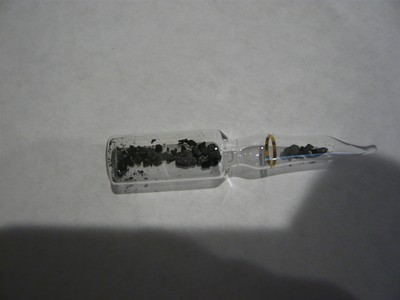
(Everything is a lot more metallic than it appears in the photo, because my inside lighting is frankly terrible.)
The larger lumps are actually coalesced arsenic, that appeared to have melted together! I assume this is due to the carbon dioxide (from the charcoal,
the oxygen, and heat) causing enough pressure inside the tube to mess with the phase diagram and cause the arsenic to melt rather than sublime. Works
for me - now I didn't have to worry about scraping off foil!
I am very glad to have a sample of arsenic in my collection, and also to never have to touch this stuff again.
Elements Collected:52/87
Latest Acquired: Cl
Next in Line: Nd
|
|
|
MrHomeScientist
International Hazard
    
Posts: 1806
Registered: 24-10-2010
Location: Flerovium
Member Is Offline
Mood: No Mood
|
|
Congratulations! I always love seeing these elemental isolations. So you simply ground up the ore, mixed with charcoal, and heated in a sealed pipe to
sublime the As? I wonder what the rest of the products were.
|
|
|
Zyklon-A
International Hazard
    
Posts: 1547
Registered: 26-11-2013
Member Is Offline
Mood: Fluorine radical
|
|
Nice! I should buy some Skutterudite and try this, sounds like fun. And you're still alive, so that's a plus.
|
|
|
elementcollector1
International Hazard
    
Posts: 2684
Registered: 28-12-2011
Location: The Known Universe
Member Is Offline
Mood: Molten
|
|
Quote: Originally posted by Zyklonb  | | Nice! I should buy some Skutterudite and try this, sounds like fun. And you're still alive, so that's a plus. |
I think that was more luck than skill on my part - there were plenty of leaks from the tube, even after I triple-folded the flattened copper pipe!
In addition, make sure you do this outside, obviously.
I would honestly attempt the wet route for a sample of arsenic - for this, I got fed up and got lucky.
Elements Collected:52/87
Latest Acquired: Cl
Next in Line: Nd
|
|
|
blogfast25
International Hazard
    
Posts: 10562
Registered: 3-2-2008
Location: Neverland
Member Is Offline
Mood: No Mood
|
|
Nice. Carbothermic reduction in action.
|
|
|
elementcollector1
International Hazard
    
Posts: 2684
Registered: 28-12-2011
Location: The Known Universe
Member Is Offline
Mood: Molten
|
|
To be fair, I should probably have used significantly less carbon. The stoichiometric amount for the amount of air in the tube would probably
be milligrams, instead of the equal volume (to the skutterudite) I decided to add. This ended up being a drawback because the pressure of the
CO2 ended up causing it to work its way out of the tube through tiny cracks in the flattened ends, offgassing and scaring the pants off of
me every time.
I wonder what would have to be done for a perfectly sealed tube? Likely it would have to be welded shut.
Elements Collected:52/87
Latest Acquired: Cl
Next in Line: Nd
|
|
|
blogfast25
International Hazard
    
Posts: 10562
Registered: 3-2-2008
Location: Neverland
Member Is Offline
Mood: No Mood
|
|
Quote: Originally posted by elementcollector1  |
To be fair, I should probably have used significantly less carbon. The stoichiometric amount for the amount of air in the tube would probably
be milligrams, instead of the equal volume (to the skutterudite) I decided to add. This ended up being a drawback because the pressure of the
CO2 ended up causing it to work its way out of the tube through tiny cracks in the flattened ends, offgassing and scaring the pants off of
me every time.
I wonder what would have to be done for a perfectly sealed tube? Likely it would have to be welded shut. |
No, no, EC1: excess is good here, trust me. You may have slightly overdone it but that's partly why it worked.
Stoichiometric would have been as slow as grass growing.
|
|
|
elementcollector1
International Hazard
    
Posts: 2684
Registered: 28-12-2011
Location: The Known Universe
Member Is Offline
Mood: Molten
|
|
In recent news, it turns out the waste material had yet more arsenic to yield. This might need some purification and sublimation, but I was wondering
if anyone wanted a sample of arsenic for their own purposes. Not sure on prices, as I am unsure of how much I actually have (some of the ore was
dumped in that waste container too...)
Elements Collected:52/87
Latest Acquired: Cl
Next in Line: Nd
|
|
|
elementcollector1
International Hazard
    
Posts: 2684
Registered: 28-12-2011
Location: The Known Universe
Member Is Offline
Mood: Molten
|
|
Hmm. It seems all the pics in this thread died. I'll just re-upload what I have, then:
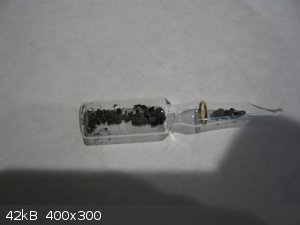
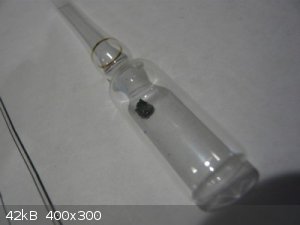
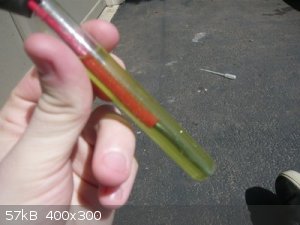
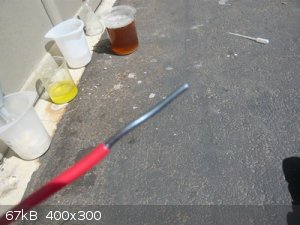
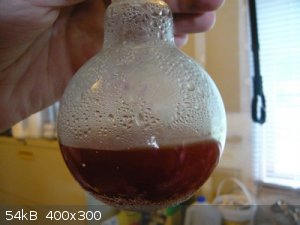
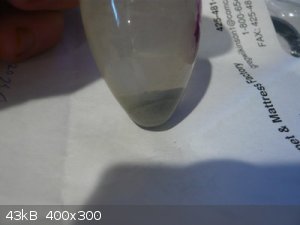
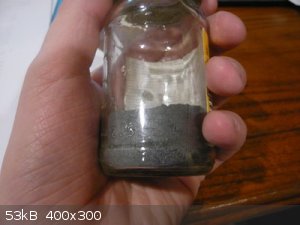
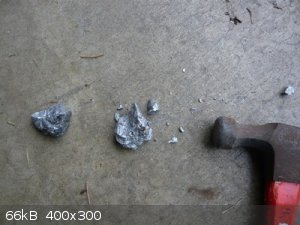
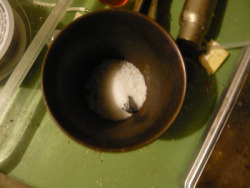
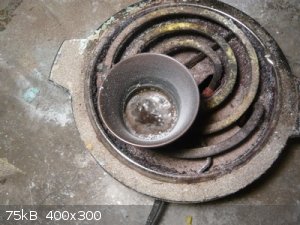
Elements Collected:52/87
Latest Acquired: Cl
Next in Line: Nd
|
|
|
| Pages:
1
..
4
5
6 |